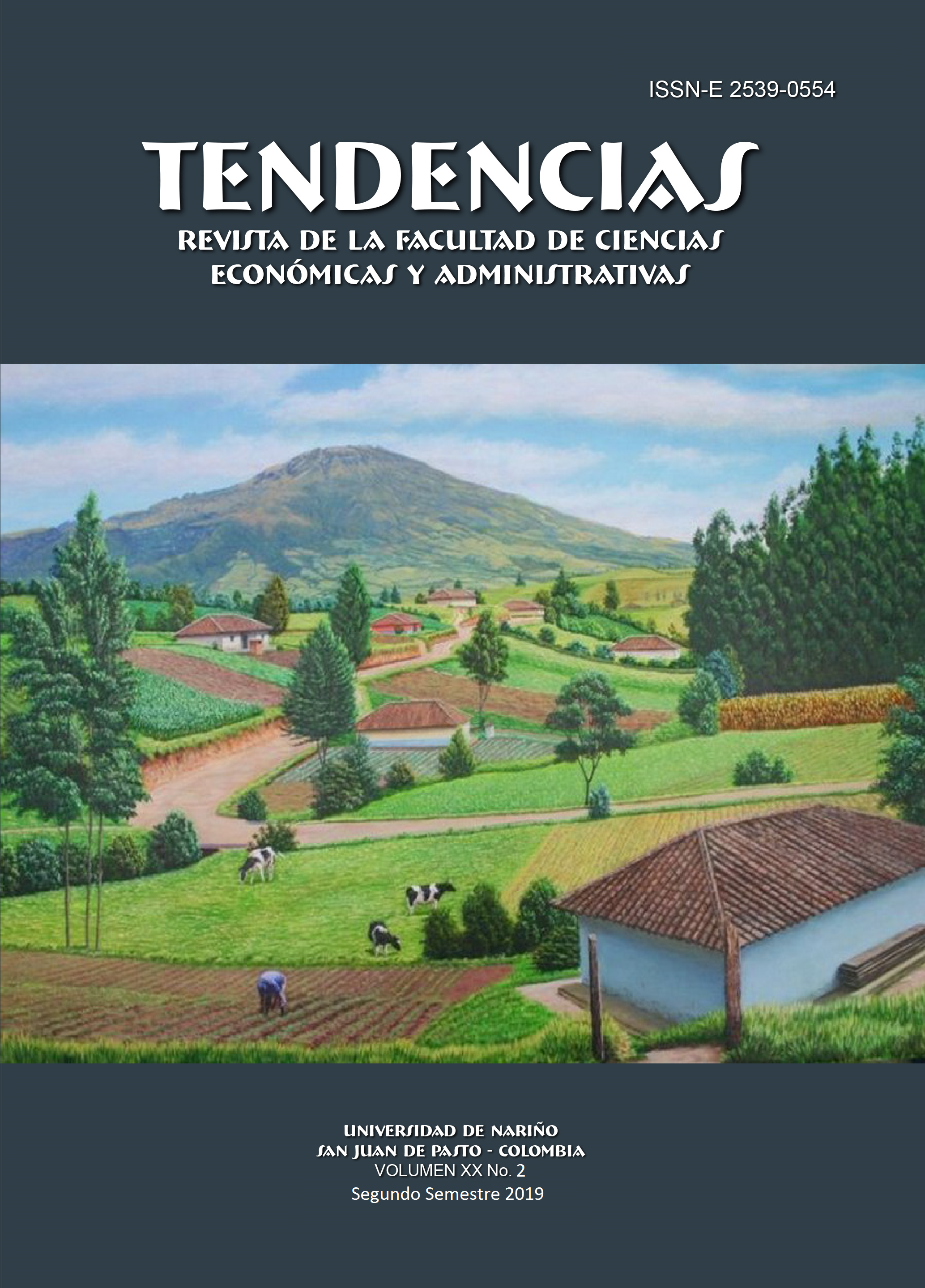El marketing olfativo como posicionamiento de marcas
DOI:
https://doi.org/10.22267/rtend.192002.123Palabras clave:
marketing sensorial, marketing olfativo, merchandising olfativo, nota, aromaResumen
El objetivo de este estudio se basa en analizar la percepción que tienen los consumidores sobre el marketing sensorial olfativo, como estrategia utilizada para el posicionamiento de las marcas.
El sentido del olfato siempre ha sido un factor determinante en la toma de decisiones del ser humano, sin embargo, los estudios que existen sobre el proceso que vincula los aromas, el olfato y las marcas. Son descriptivos y de carácter interno por esta razón no pueden confirmar que un aroma estratégico, aplicado a una empresa o marca sea un factor de posicionamiento efectivo.
Algunas marcas ya utilizan el sentido del olfato como activador de relaciones, emociones y sentimientos con sus clientes, aprovechando que sentido del olfato no presenta saturación publicitaria, y tiene comunicación directa con la memoria, sin embargo, es una estrategia aislada que migra de otros países y que para la mayoría de empresas es un concepto nuevo como aplicación de marketing sensorial.
Se realizó una investigación cuantitativa de tipo exploratoria utilizando encuestas aplicadas a (120) consumidores, entre hombre y mujeres en edades 18 a 60 años con procesos de compra y consumo en el territorio colombiano.
Los hallazgos relacionan positivamente al consumidor y los aromas, también se puede evidenciar lo novedoso que es para el mercado el concepto de marketing olfativo, confirmando que algunos consumidores si conocen este tipo de estrategias, y la han experimentado en grandes marcas, como hoteles, restaurantes y sector vestuario.
Como conclusiones se puede evidenciar una disposición por parte de los consumidores en la implementación de estrategias sensoriales olfativas para las marcas. Convirtiéndose esto en una oportunidad de mercado interesante para las empresas, desarrolladoras y distribuidoras de marketing olfativo, ya que el consumidor en general está dispuesto a disfrutar de la estrategia sensorial olfativa.
Descargas
Citas
(1) Alzate, M; & Luján, D. (2017). Psicología y marketing olfativo : una exploración desde la psicología sobre el impacto que ejerce en el consumidor el uso de odotipos. Recuperado de: http://200.24.17.74:8080/jspui/handle/fcsh/1117
(2) Arboleda, A; & Alonso, J. (2015). El aroma al evaluar el involucramiento del consumidor con un producto y su percepción de calidad. Estudios Gerenciales, 31(137), 403–410. https://doi.org/10.1016/j.estger.2015.07.003
(3) Avendaño C; Paz, G; Rueda, L; Avendaño, W; Paz, L; & Rueda, G. (2015). Estímulos auditivos en prácticas de neuromarketing. Caso: Centro Comercial Unicentro, Cúcuta, Colombia. Recuperado de: www.unicentrocucuta.com
(4) Bonadeo, B. (2011). Odotipo. Recuperado de: www.austral.edu.ar
(5) Bonadeo, M. (2005). Odotipo : historia natural del olfato y su función en la identidad de marca. Universidad Austral, Facultad de Comunicación.
(6) Calabretti, A; Gabrielli, L; Vesnaver, R; Bader, S; & Verderio, S. (2006). Il marketing olfattivo: Nuova frontiera del packaging alimentare. Industrie Alimentari, 45(464), 1282–1284.
(7) Cuatrecasas, L. (2017). El efecto del aroma en la intención de compra de un paquete vacacional. Anuario Electrónico de Estudios En Comunicación Social “Disertaciones,” 11(1), 150. https://doi.org/10.12804/revistas.urosario.edu.co/disertaciones/a.5004
(8) De Garcillán, M. (2015). Persuasión a través del marketing sensorial y experiencial. Opción, 31(2), 463–478. Recuperado de: http://www.redalyc.org/html/310/31045568027/
(9) Díez, E; Landa, F; Cossío, F; & Zorrilla, M. (1996). Merchandising. Recuperado de: http://soda.ustadistancia.edu.co/enlinea/3momento_admoncomercialymercadeo_dianaospina/el_merchandising.html
(10) Fuentes, A; Fresno, M; Santander, H; Valenzuela, S; Gutiérrez, M; & Miralles, R. (2011). Sensopercepción olfatoria: Una revision. Revista Medica de Chile, Vol. 139, pp. 362–367. https://doi.org/10.4067/S0034-98872011000300013
(11) Gaby, J; & Tepper, B. (2019). A Comparison of Hedonic and Emotional Responses to Common Odors Delivered by qPODs (Portable Olfactive Devices) and Traditional Sniff Jars. Food Quality and Preference, 103804. https://doi.org/10.1016/j.foodqual.2019.103804
(12) Gómez, C; Manzi, M; & Galindo, T. (2014). El scent marketing: una revisión bibliográfica.
(13) Gómez, C; Andres, M; Puertas, M; & Galindo, T. (s.f.). El scent marketing: una revisión bibliográfica Scent marketing: a bibliographic review.
(14) Hernández, M; Tomaseti, E; & Miranda, E. (2016). Marketing olfativo: la influencia del olor sobre la memoria. Anuario de Jóvenes Investigadores, (9), 244–247. Recuperado de: https://dialnet.unirioja.es/servlet/articulo?codigo=5981388
(15) Hernández, R; Fernández, C; & Baptista, P. (2006). Metodología de la investigación. Recuperado de: https://www.studocu.com/en/document/instituto-tecnologico-de-veracruz/politicas-publicas/book-solutions/sampieri-metodologia-de-la-investigacion-4ta-edicion-sampieri-2006-ocr/2248528/view
(16) Hummel, T; Sekinger, B; Wolf, S; Pauli, E; & Kobal, G. (1997). “Sniffin” sticks’. Olfactory performance assessed by the combined testing of odor identification, odor discrimination and olfactory threshold. Chemical Senses, 22(1), 39–52. https://doi.org/10.1093/chemse/22.1.39
(17) Krishna, A; & Schwarz, N. (2014). Sensory marketing, embodiment, and grounded cognition: A review and introduction. Journal of Consumer Psychology, 24(2), 159–168. https://doi.org/10.1016/j.jcps.2013.12.006
(18) Mascaraque, L; & Ramón, A. (2017). El olfato. Recuperado de: https://www.digitaliapublishing.com/visor/49514
(19) Ovejero, A. (1993). La teoría de la disonancia cognitiva. Psicothema, 5(1), 201–206. Recuperado de: http://www.redalyc.org/articulo.oa?id=72705116
(20) Pereda, P. (2015). Arte de la guerra de Sunzi. Revista de Artes Marciales Asiáticas, 3(4), 81. https://doi.org/10.18002/rama.v3i4.394
(21) Revisi, C. (2011). Neuroepitelio olfatorio. 362–367.
(22) Schmitt, B. (1999). Experiential marketing castellano. Libro, 15(1–3), 1–17. Recuperado de: http://www.ucipfg.com/Repositorio/MGTS/MGTS14/MGTSV-09/materialesnuevos/semana4/MercadeoVivencial-ExperientialMarketing.pdf
Descargas
Publicado
Cómo citar
Número
Sección
Licencia
Aquellos autores/as que tengan publicaciones con esta revista, aceptan los términos siguientes:
Esta revista está bajo una Licencia Creative Commons Reconocimiento-NoComercial 4.0 Internacional License. Los artículos se pueden copiar, distribuir, adaptar y comunicar públicamente, siempre y cuando se reconozcan los créditos de la obra y se cite la respectiva fuente. Esta obra no puede ser utilizada con fines comerciales.
Para aumentar su visibilidad, los documentos se envían a bases de datos y sistemas de indización.
El contenido de los artículos es responsabilidad de cada autor y no compromete, de ninguna manera, a la revista o a la institución.







































